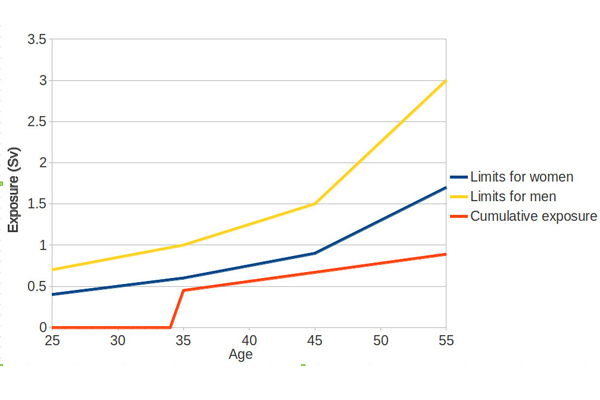Radiation Fears Shouldn't Hold Back Mars Colonization (Op-Ed)


Bas Lansdorp, Mars One co-founder and CEO, contributed this article to SPACE.com's Expert Voices: Op-Ed & Insights.
Mars One aims to establish a permanent human settlement on Mars in 2023, requiring no return mission.
The absence of a return mission reduces the radiation exposure from galactic cosmic rays. These cosmic rays are hard to shield against without the use of a prohibitive shielding mass, which would require more than 10 times the standard spacecraft shielding. Reducing the time spent traveling through space — and, thus, the exposure from the cosmic rays — is significant, as these rays are the source of 95 percent of the radiation exposure, according to a recent paper published May 31 in the journal Science.
For the study, Cary Zeitlin of the Southwest Research Institute and his colleagues calculated radiation exposure for a 360-day return trip to Mars to be 662 plus or minus 108 millisieverts(mSv), equivalent to the radiation of about 10,000 chest X-rays. The researchers determined that value using measurements from NASA's Mars Science LaboratoryRadiation Assessment Detector (RAD), onboardthe spacecraft while the Curiosity rover traveled to Mars in 2012. [Photos: Mars One Wants You as a Martian Colonist]
This finding from RAD indicates that for a human traveling to and living on the Red Planet, the risk of a fatal cancer resulting from radiation exposure lies within the currently accepted risk for low-Earth-orbit astronauts.
Radiation exposure during space travel
In transit to Mars, the Mars One crew will be protected from the other source of radiation — solar particles — by the structure of the spacecraft, which will provide 10 to 15 grams per square centimeter (2.3 to 3.4 ounces per square inch) of shielding, equivalent to 4 to 6 inches (10 to 15 cm) of water.
Breaking space news, the latest updates on rocket launches, skywatching events and more!
That level of protection will not suffice in the case of coronal mass ejections, solar flares and other sources of solar particle events.
Taking their cue from an onboard solar-flare forecasting and radiation measurement system the crew will retreat to a dedicated radiation shelter located in a hollow water tank, where shielding will increase to a total of 40 grams per square cm (9 ounces per square inch).
Assuming the exposure levels the RAD experienced, Mars One's crew will be exposed to 386 plus or minus 63 mSv of radiation on its 210-day journey to Mars in 2022, which is equivalent to 58 percent of the total exposure of a 360-day return trip, as calculated by the recent Science study. [Could Radiation Harm Astronauts Traveling to Mars? (Video)]
Radiation exposure on Mars
On Mars, radiation exposure is considerably less than the exposure in space. Thanks to the shielding provided by the planet itself and its atmosphere, Mars' surface receives 30 microsieverts (0.03 millisieverts) of radiation per hour during solar minimum, according a NASA technical paper entitled "Space Radiation Cancer Risk Projections for Exploration Missions: Uncertainty Reduction and Mitigation."
The research, conducted by Francis Cucinotta, chief scientist at the NASA Space Radiation Program and his colleagues, found that the exposure is reduced by about 50 percent during solar maximum because solar particles actually decrease galactic rays.
The Mars One habitat will be covered by a necessary layer of soil that provides shielding even against galactic cosmic rays. Sixteen feet (5 meters) of Martian soil provides the same protection as the Earth's atmosphere — equivalent to 1,000 grams per square cm(227.6 ounces per square inch) of shielding. The Mars One habitat can support a soil layer 36 feet (11 m) thick. If the settlers spend, on average, two hours per day outside the habitat, their individual exposure adds up to 22 mSv per year.
Radiation exposure limits
The world's space agencies have put in place radiation exposure limits for astronauts over their careers. The agencies restrict the astronauts to serve low-Earth-orbit missions and do not consider the longer durations and different conditions of interplanetary missions.
NASA low-Earth-orbit radiation exposure limits were designed to keep the risk of radiation-induced fatal cancer below 3 percent, according to the National Council on Radiation Protection and Measurements report 132. The limits depend on the sex and age of the astronaut.
According to that report, young females are most susceptible to radiation-induced fatal cancer and therefore have the lowest allowed exposure. For International Space Station (ISS) operations, NASA uses the 3 percent risk with a confidence level applied to it, resulting in doses about three times lower than the acceptable limits, according to National Council on Radiation Protection and Measurements report 142.
Considering a scenario where an inhabitant receives the upper limit of radiation of 449 mSv during the 210 day transit to Mars, for a female inhabitant younger than 35, the exposure amounts to about 3 percent risk for her lifetime (not including NASA ISS confidence levels). Risks are lower for women departing at a higher age, and especially for male colonists. On Mars, the risk can be managed by monitoring each crew member's radiation exposure and limiting the surface exploration time of those who are most at risk.
Comparing the risks
The risk from radiation is visualized more easily when compared to other risks to which humans are exposed.
For example, an average person in the United States has a 21 percent risk of dying from cancer, according to the American Cancer Society's Cancer Facts and Figures 2013. The increased risk attributed to space travel is, on average, smaller than the risk add-on from smoking: Lifelong smokers who smoke less than 25 cigarettes per day raise their risk of dying of lung cancer from below 1 percent (for nonsmokers) to 15.9 percent (men) or 9 percent (women), according to research conducted by Richard Peto and colleagues at Radcliffe Infirmaryin the United Kingdom and published in the British Medical Journal in 2000.
Even back on Earth, the risk of dying from an adventure like climbing Mount Everest was 2 percent until 2006, according to AdventureStats.com.
Going to Mars, like climbing the highest mountains, is not for everyone. And those explorers are aware that mankind's great adventures will always be risky.
Mars One is evaluating the risks involved in the mission, including those from radiation exposure, and will clearly explain each risk to all stakeholders and, most importantly, to its crews.
One of Mars One's main responsibilities is to find suitable men and women for the mission, and then train and prepare them for the challenge. The crew members will ultimately decide if the risk is worth the reward.
Colonizing Mars is the next giant leap for humankind; radiation should not hold us back.
You can learn more about how to apply to the Mars One project here: http://applicants.mars-one.com/
The views expressed are those of the author and do not necessarily reflect the views of the publisher. This article was originally published on SPACE.com .



